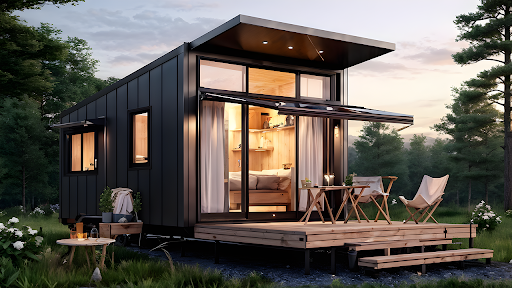Would you ever consider living in a home that’s just a few hundred square feet? At first glance, small-scale housing might sound limiting. Yet more people are embracing micro homes as a practical, creative solution to rising housing costs, environmental concerns, and a desire for simpler, more intentional living. Recent data indicates that the average single-family home built in the United States is still over 2,400 square feet—space many homeowners simply don’t use. This excess creates higher monthly bills, more maintenance, and a greater environmental footprint. In contrast, micro homes (often defined as residences under 400 square feet) prove that thoughtful design can transform even the smallest footprint into a fully functional, comfortable retreat.
Why Micro Homes Are Gaining Momentum
Microhomes haven’t always been in the mainstream, but their popularity has grown significantly over the past decade. Some industry watchers note that small-home sales and custom builds have climbed in recent years. Meanwhile, housing surveys suggest that many singles, young professionals, retirees, and even families are looking for more flexible and attainable ways to own or rent a home.
Shifting Lifestyles and Economics
One factor behind this surge is a shift in lifestyles and economic realities. Many first-time buyers, for example, are finding it difficult to afford a full-sized house. Construction costs and mortgage rates can be daunting, while wages in some regions have stayed fairly static. By contrast, a well-designed micro home often costs a fraction of a traditional property to build or purchase. In some places, the total cost for a micro house on wheels might be less than a single year’s rent for a larger apartment.
What’s more, data shows that a considerable percentage of micro-home dwellers live mortgage-free, alleviating a huge financial burden. Freed from high monthly payments, people can invest in travel, pursue passions, or build savings. The modest square footage means that utility bills and maintenance costs are also greatly reduced.
Minimalism and Environmental Consciousness
Another draw is the growing acceptance of minimalism. Many individuals realize they don’t need endless rooms and closets filled with items. Moving into a micro home forces a thoughtful examination of possessions—paring down to what truly matters. This decluttering can be liberating, prompting a shift toward experiences over material accumulation.
Environmental concerns also play a major role. Because microhomes use fewer building materials and require less heating or cooling, they have a smaller carbon footprint. Many owners equip them with solar panels or rainwater harvesting systems, making them even more eco-friendly. It’s a practical approach that resonates with those who want to live sustainably while also enjoying homeownership.
Versatility in Urban, Suburban, and Rural Settings
These small spaces aren’t just for off-grid aficionados or nature lovers. Urban dwellers might opt for a micro-apartment in a prime neighborhood, balancing a compact floor plan with walkable access to shops, restaurants, and cultural venues. In suburban areas, backyard accessory dwelling units (ADUs) can generate rental income or provide flexible guest accommodations. Rural inhabitants might build a small cabin that embraces natural surroundings. Micro homes adapt well in all these contexts, explaining why they’re finding a foothold across regions.
Types of Micro Homes and Their Unique Appeal
A “micro home” can mean different things to different people. From accessory units tucked behind full-sized houses to shipping containers transformed into modern dwellings, below are some of the most popular categories you’ll find.
Tiny Houses on Wheels (THOWs)
Tiny houses on wheels combine the benefits of a small home with the freedom of mobility. Built on trailer chassis, these structures usually measure between 100 and 400 square feet. They’re often crafted to residential standards, meaning quality insulation, windows, and building materials that can stand up to various climates. While they look similar to RVs, they’re typically more customized, cozier, and more permanent in feel.
- Why They’re Popular:
- Flexibility: Owners can move without leaving their homes behind.
- Lower Costs: Some tiny houses on wheels cost significantly less than standard homes.
- Off-Grid Potential: Solar power setups and composting toilets are common features, allowing for a nomadic, environmentally conscious lifestyle.
Container Homes
Old shipping containers once used for freight transport are a surprising yet highly effective choice for micro-living. These steel boxes provide a robust structural shell that can be converted into fully functional homes. Some container dwellings incorporate multiple units, creating layouts that feel less linear and more open.
- Why They’re Popular:
- Eco-Friendly: Repurposing containers reduces new material usage.
- Modern Aesthetic: The industrial look can be striking, making these homes a hit with fans of contemporary or minimalist styles.
- Speed of Construction: With the main steel frame in place, finishing the interior can be faster than starting from scratch.
Accessory Dwelling Units (ADUs)
ADUs are small secondary homes that share a parcel with a larger residence. They might be a converted garage, a basement apartment, or a standalone structure in the backyard. Typically, these range from 300 to 800 square feet. Local zoning laws have increasingly embraced ADUs as a gentle way to add density in established neighborhoods.
- Why They’re Popular:
- Income Generation: Owners can rent them out, creating a steady revenue stream.
- Flexible Housing: Perfect for multi-generational living, guest quarters, or even a home office.
- Community Benefits: Helps ease local housing shortages without major neighborhood disruption.
Micro Apartments
In many urban areas, micro-apartments have cropped up as a solution for those who prioritize location over square footage. Often less than 400 square feet, they focus on efficient layouts and can include built-in furniture like fold-down beds or convertible tables.
- Why They’re Popular:
- Affordability in High-Cost Cities: The monthly rent or purchase price can be relatively lower.
- Shared Amenities: Many buildings compensate for compact units by offering communal lounges, rooftop decks, or co-working areas.
- Minimalist Convenience: Urban dwellers with busy lifestyles find them easy to maintain, with everything needed in one compact space.
Cabin-Style Retreats
Cabin-inspired microhomes often feature pitched roofs, wooden interiors, and cozy lofts. They can range from quaint rustic hideaways to chic modern cottages.
- Why They’re Popular:
- Nature Focus: Perfect for rural or forested settings, blending indoor and outdoor living.
- Retreat Aesthetic: Encourages relaxation and a sense of escapism.
- Simplicity: Often a single main room plus a loft, or a small footprint with just the essentials.
Design Essentials for Comfortable Micro Living
Living in a few hundred square feet might seem daunting, but thoughtful design transforms even the tiniest footprint into a welcoming space. Below are some key principles and tips for creating a micro home that feels both functional and stylish.
Multi-Functional Furniture
One secret to microliving is furniture that serves more than one purpose. Consider:
- Murphy Beds: These fold away during the day to free up floor space. Some models reveal a sofa or desk underneath.
- Lift-Top Tables: Coffee tables can quickly become dining surfaces or work desks.
- Stairs with Storage: If you have a loft, incorporate drawers and cabinets into each step.
- Built-In Seating: Banquettes or benches with storage compartments keep clutter out of sight.
When every item has a “hidden” job, your living area remains flexible, accommodating different needs throughout the day.
Light and Bright Aesthetics
Small spaces can feel cramped without ample light. Maximize natural illumination with:
- Large Windows or Skylights: Letting daylight in creates an illusion of spaciousness.
- Glass Doors: Sliding or French doors connect indoors to outdoor decks or patios.
- Bright Color Schemes: Pale hues on walls, ceilings, and larger furniture pieces open up the room visually.
- Strategic Lighting: Layered lighting—ceiling fixtures, sconces, and task lamps—provides depth and ambiance.
Open Floor Plans and Vertical Space
Without walls breaking up the layout, a micro home can feel much larger. Designers often use:
- Lofts: Sleeping areas tucked above living spaces make the most of vertical volume.
- Minimal Partitions: Curtains or sliding panels can substitute for solid walls.
- Zoning Cues: A different floor level, a rug, or a lighting fixture helps define separate “rooms” in an open plan.
- Vertical Shelving: Storing items above eye level keeps floors clear, an essential strategy when space is tight.
Smart Storage Solutions
Storage is critical in micro-living. Some popular strategies include:
- Under-Floor Storage: A raised platform can hide clothing, seasonal items, or linens.
- Toe-Kick Drawers: In kitchens and bathrooms, the space beneath cabinets provides valuable compartments.
- Hanging Organizers: Over-door or wall-mounted racks and baskets reduce countertop clutter.
- Custom Built-Ins: Whether it’s a recessed niche in the bathroom or shelves embedded in a staircase, purpose-built storage ensures no inch goes to waste.
Personal Touches
Lastly, don’t neglect aesthetics. Although micro homes favor minimalism, personalization still matters:
- Textiles: Cozy throw blankets, soft rugs, and plush cushions add warmth.
- Greenery: Even a few potted plants or a small herb garden can bring life to a compact interior.
- Wall Art or Accents: A single striking piece can define a room’s character without crowding it.
- Textures: Mixing wood, metal, or natural fibers can lend depth to otherwise small areas.
Sustainability and Off-Grid Possibilities
Many microhomes incorporate eco-friendly elements that reduce monthly expenses and environmental impact. A smaller house requires fewer resources to build and maintain, making it easier to aim for net-zero energy or an off-grid setup.
Eco-Conscious Materials
- Reclaimed Wood: Salvaged planks can become floors, walls, or countertops.
- Recycled Metal or Insulation: Repurposed steel, shipping containers, or recycled fiberglass insulation cut down on new materials.
- Non-Toxic Finishes: Low- or zero-VOC paints and sealants improve indoor air quality—especially important in a tight space.
- Bamboo and Cork: Fast-growing, renewable materials offer stylish surfaces while minimizing ecological harm.
Efficient Heating and Cooling
A small footprint means quicker heating or cooling, but that doesn’t guarantee comfort unless the structure is well-insulated and sealed. Popular approaches include:
- High R-Value Insulation: Structural insulated panels (SIPs) or spray foam can help maintain comfortable interior temperatures.
- Mini-Split Systems: Compact HVAC units work efficiently and quietly in limited areas.
- Wood-Burning Stoves: In cabin-style micro homes, small stoves provide off-grid warmth in cooler regions.
Renewable Energy Systems
Since micro homes typically have low energy demands, outfitting them with renewable power is more affordable and manageable:
- Solar Panels: Even a modest solar array can cover lighting, laptop charging, and refrigeration.
- Rainwater Harvesting: In certain climates, rooftop systems can collect enough water for toilets, showers, or laundry (with appropriate filtration).
- Composting Toilets: These eliminate the need for sewer connections, making remote locations more feasible.
Flexible Infrastructure
Micro homes designed for off-grid living often include:
- Battery Storage: Back-up power for nighttime or cloudy days.
- Propane or Wood-Fuel Appliances: Reliable cooking and heating in remote areas.
- Greywater Recycling: Using wastewater from sinks or showers to flush toilets or irrigate gardens.
Such systems enable homeowners to place their dwellings in scenic, secluded areas—whether in the mountains, near a lake, or tucked into a lush forest—without needing complex utility hookups.
Making the Most of Micro Living: Practical Tips and Real-Life Inspiration
Real-Life Applications
- City Studio Lifestyle: In some downtown neighborhoods, micro apartments let residents walk or bike to work and entertainment. By using built-in storage and convertible furniture, tenants enjoy tidy, modern spaces without paying sky-high rents for larger units.
- Backyard ADU Haven: A detached tiny cottage can serve as a guest suite or a rental. Some homeowners convert it into a creative studio or office for remote work. The best part? The occupant benefits from privacy, while still having easy access to friends or family in the main house.
- Off-Grid Cabin Retreat: A minimalistic wood cabin in a quiet rural area can supply fresh air, scenic views, and peace of mind. Even with a limited footprint, you can have comfortable sleeping lofts, a compact bathroom, and an outdoor deck that expands the living space.
Expert Tips for First-Time Micro Dwellers
- Purge Before You Pack: When moving into a micro home, sort belongings into “must-haves,” “nice-to-haves,” and “donations.” You’ll be surprised by how many items fall into the last category.
- Embrace Vertical Storage: Think upwards. Floor-to-ceiling shelving, hanging racks, and lofted zones keep the ground level clear.
- Opt for Quality Over Quantity: Fewer items mean you can invest in well-made pieces—like a sturdy mattress or a durable countertop.
- Don’t Skimp on Windows: Natural light transforms tight interiors, helping you feel more connected to the outside world.
- Plan for Flexibility: If your micro home will also be an office, craft room, or guest room occasionally, choose layouts and furniture that adapt quickly.
Small-Space Success Stories
- Remote Cabin Couple: A pair of nature enthusiasts built a 300-square-foot cabin in a secluded region. Through solar panels, a rain catchment tank, and an efficient wood stove, they live with minimal bills. They added a sleeping loft under an A-frame roof, leaving enough room below for a small dining table and cozy seating area.
- Urban Professional in a Micro Studio: A young designer relocated for work and chose a micro-studio with a wall bed. By day, the main living area doubles as a lounge or office space. A single closet with built-in shelving keeps wardrobe essentials neat. Modern lighting and tasteful décor make the space feel anything but cramped.
- Family-Driven ADU: Retirees added a 400-square-foot ADU behind their daughter’s home. Designed with accessibility in mind—wide doorways, single-level living—it allows them independence while staying close to family. Strategically placed skylights and a front porch expand their sense of space.
These examples show that “tiny” does not mean uniform. Personal preferences, climate considerations, and local zoning rules shape each micro-dwelling’s design. The unifying theme is resourcefulness—a custom fit that meets real needs in compact dimensions.
Conclusion
Microhomes are more than a passing trend. They represent a meaningful shift in how we define comfort, sustainability, and financial freedom in modern housing. By distilling living space to its most essential elements, micro dwellers discover that quality of life can improve when square footage is scaled back. Costs are often lower, environmental footprints shrink, and many residents feel a renewed connection to their neighborhoods or natural surroundings.
Whether you’re intrigued by a wheels-friendly tiny house, a cozy off-grid cabin, or a sleek city micro-apartment, the key to success lies in thoughtful design and planning. Identify your must-haves—like a functional kitchen, a comfortable bed, or a space to work from home—and then explore creative ways to integrate those essentials without crowding the layout. Seek out convertible furniture, strategic storage solutions, and plenty of natural light. Consider greener materials and energy sources to further reduce your impact and costs.
Ready to dive in? Think about starting with a small renovation project—maybe turning that unused garage into an accessory unit or experimenting with multi-purpose furniture in your current space. Even if you’re not planning to live full-time in a micro home, exploring these design principles can lead to a more mindful, purposeful approach to any living environment. After all, the future of small living is really about living smarter, and it proves that sometimes less truly can be more. If you have ideas or questions, join the conversation—your next big inspiration for living small might be just around the corner.







